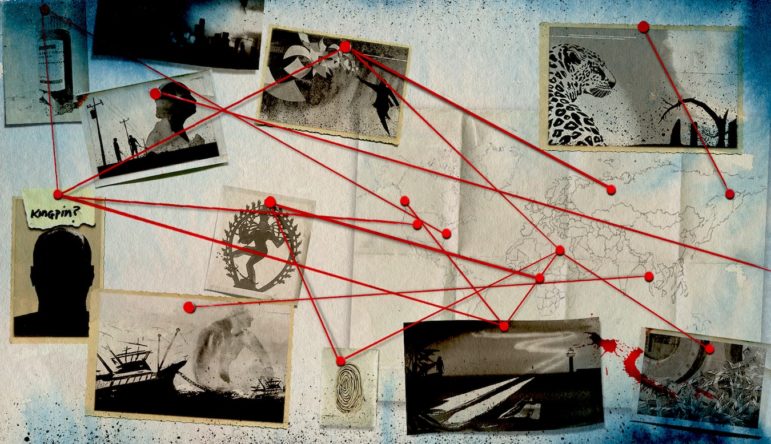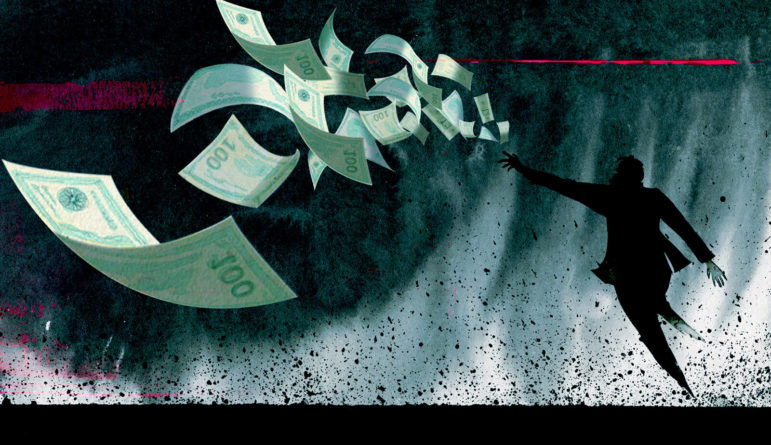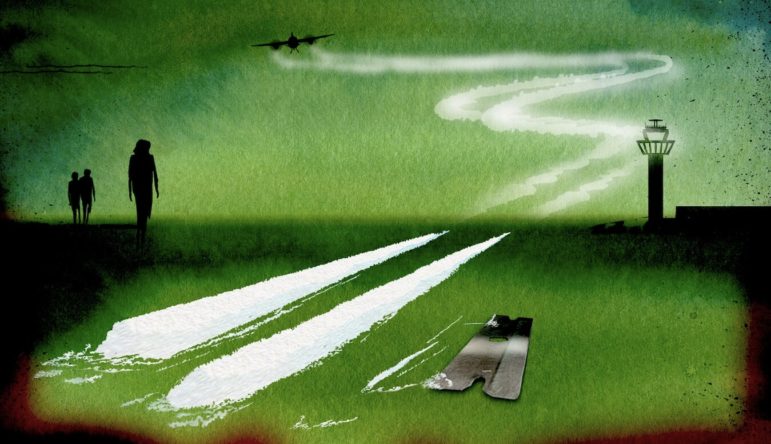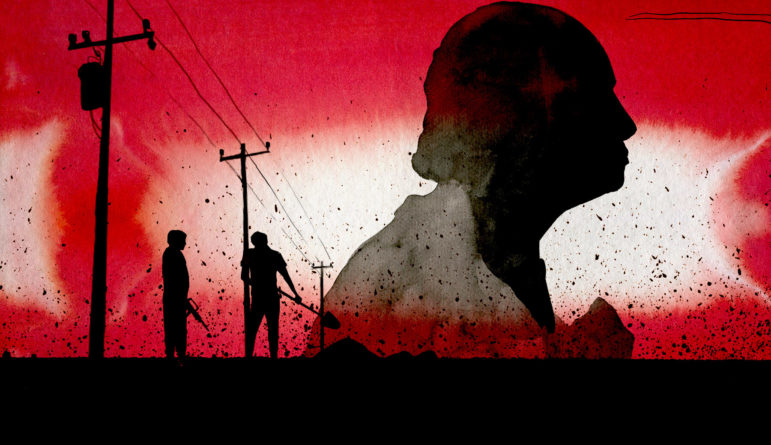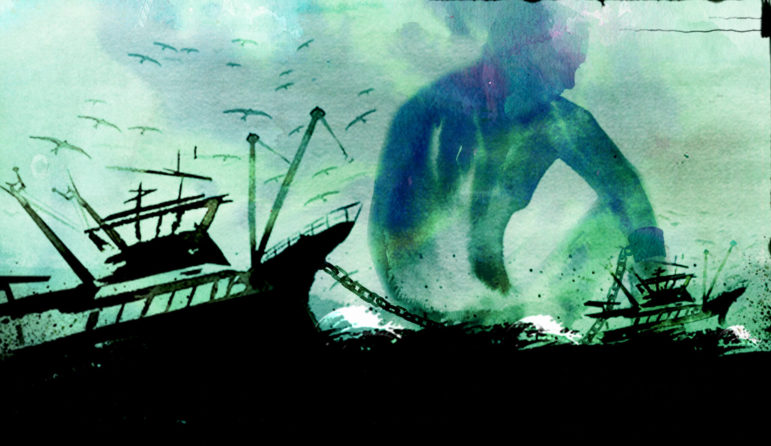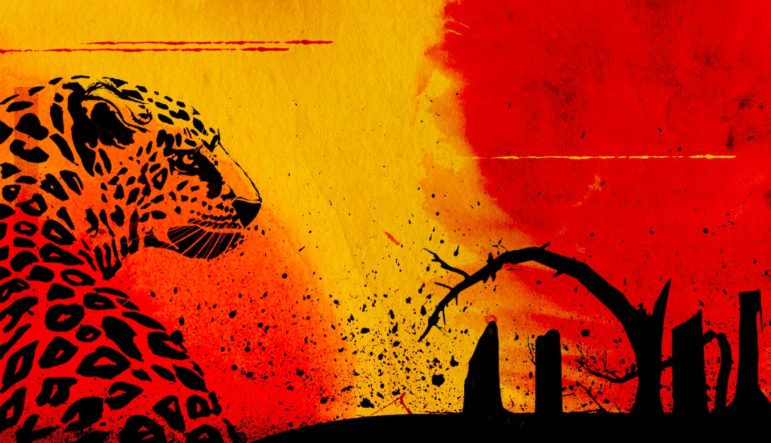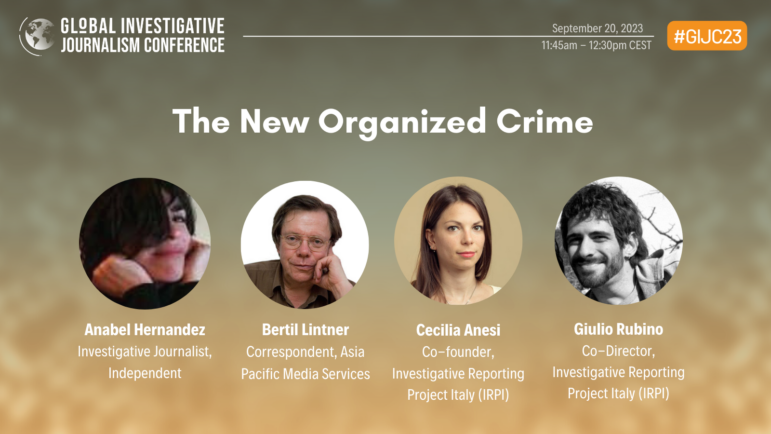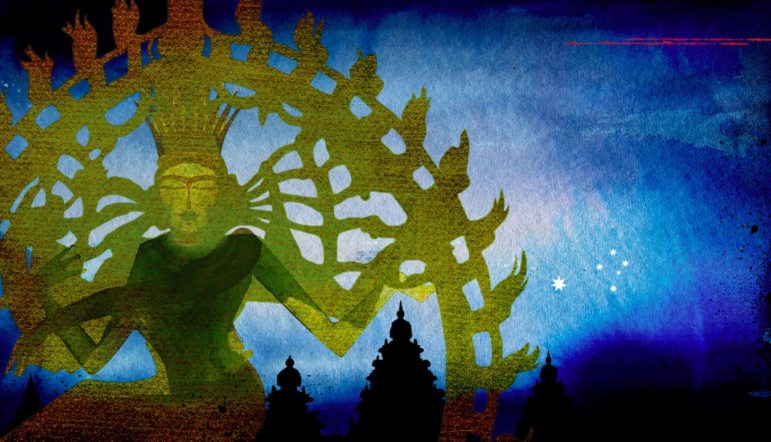

Illustration: Ann Kiernan for GIJN
Organized Crime Chapter 8 – Antiquities Trafficking
Read this article in
Guide Resource
Reporter’s Guide to Investigating Organized Crime
Chapter Guide Resource
Organized Crime – Introduction
Chapter Guide Resource
Organized Crime Chapter 1 – Money Laundering
Chapter Guide Resource
Organized Crime Chapter 2 – Drug Trafficking
Chapter Guide Resource
Organized Crime Chapter 3 – Cybercrime
Chapter Guide Resource
Organized Crime Chapter 4 – Forced Disappearances
Chapter Guide Resource
Organized Crime Chapter 5 – Human Trafficking
Chapter Guide Resource
Organized Crime Chapter 6 – Arms Trafficking
Chapter Guide Resource
Organized Crime Chapter 7 – Environmental Crimes
Chapter Guide Resource
Organized Crime Chapter 8 – Antiquities Trafficking
Chapter Guide Resource
Organized Crime Chapter 9 – Mafia States and Kleptocracies
Chapter Guide Resource
Video: GIJC23 – The New Organized Crime
This chapter was written by Donna Yates, an associate professor in the Department of Criminal Law and Criminology at Maastricht University and a member of the Trafficking Culture Project.
The illicit trade in antiquities is a form of transnational crime that connects the theft at heritage sites to the elite world of the global art market, often via a web of organized crime. Because of the beauty and social significance of the remains of the ancient past, there is a strong demand for antiquities within North American, European, and Asian markets. These markets inspire the removal of cultural objects from lower income countries to former colonial powers, and the redefinition of shared heritage as a private commodity. In response, many antiquities-rich countries have criminalized the removal and marketing of antiquities so that cultural heritage can be preserved for the public good. Yet demand causes supply; high demand for newly discovered antiquities coupled with the absence of legitimate pathways for obtaining them has resulted in the development of criminal supply lines.
A Gray Market
The final market for trafficked antiquities is open and public. Antiquities buyers are private collectors, usually high net-worth individuals of considerable social standing, or are our most respected cultural institutions and museums. Unlike consumers of, say, illicit drugs or arms, these antiquities buyers must be able to conspicuously consume their purchases without fear of legal reprisal. Antiquities are bought to be displayed. Thus the criminal networks that have developed to supply this market launder the antiquities, cleaning the taint of theft from them, obscuring evidence of crime, and allowing otherwise upstanding buyers to suspend disbelief and engage in what research has shown is a gray market, infiltrated by organized crime.
The direct connection between art market elites and organized crime may surprise the public. Museums, auction houses, and white-collar art collectors are seen as respectable, and their links to organized criminal networks and the destructive pillaging of our collective cultural heritage is concerning. Investigations into the trafficking of antiquities have, for example, linked: Sotheby’s auction house directly to the pillaging of Cambodian temples; owners of the US craft store Hobby Lobby with the looting (and recent return) of thousands of artifacts from southern Iraq; and the destruction of Greek and Italian tombs to institutions such as the Getty Museum. These are compelling stories that reveal how global inequalities are exploited.
It is impossible to put a price tag on the value of the illicit trade in antiquities, just as it is impossible to compare it to other illegal smuggling and sales operations. Reporting on this point has been particularly poor and, as a result, many un-sourced cost estimates are repeated in the press. Experts agree that all of these figures are inaccurate. The FBI and Interpol, who are often listed as the source of such false statements as “antiquities represent the largest criminal market after drugs and arms,” have strongly denied this claim. The true social harms associated with the illicit trade in antiquities relate to the loss of culture and identity that come from the destruction of our shared heritage.

Most art crime — like the brief, 1911 robbery of the Mona Lisa by Louvre employee Vincenzo Perruggia, whose mugshot is pictured here — is nothing like the “stolen to order” professional heists portrayed in Hollywood films. Image: Shutterstock
Art Theft: Not Like the Movies
Unlike antiquities trafficking, art theft from institutions is rarer and riskier, with fewer opportunities for profit. In antiquities trafficking, criminal acts are shielded by the anonymous and undocumented nature of “stolen goods” that have spent as many as thousands of years in the ground at archaeological sites. In contrast, thefts from museums, galleries, and private residences rarely are the work of the type of Hollywood-ready art thieves. It has become a media trope in the wake of a major museum theft to speculate that artworks were “stolen to order” by “professional art thieves.” In nearly every major case, however, the reality is much more mundane and opportunistic, with thieves quickly realizing that there is no market for well-documented stolen art. Many stolen artworks end up dumped in the trash, burned and destroyed, or even returned anonymously to the museum from which they were stolen. Some art thefts have been tied to organized criminal groups, but any claim of art theft being a major or even minor focus of organized crime is questionable. As such, antiquities trafficking will be the focus of this article. However, many of the sources suggested for antiquities trafficking investigations would be useful for art theft cases as well.
Sources
Looted and trafficked antiquities are said to lack provenance — details about their origins, ownership history, and the pathways they have taken to the market. Provenance research, then, is an art world term for investigating and reconstructing object histories from fragmentary documentation, drawing on a wide and unpredictable variety of sources. Investigative journalism in this field is closely related to provenance research; writing about trafficked objects is equivalent to uncovering the story of these crimes. Each antiquities trafficking investigation has unique features and the exact sources used depend on the geographic region in question and the particulars of the case, yet nearly all will draw on some distinct source types.
First, the objects at the heart of these investigations, antiquities and artworks, are complicated in their own right. It is impossible to understand the context of the looting, trafficking, and sale of antiquities, or the social consequences of those crimes, without an understanding of the antiquities themselves. Academics are important sources of information for journalists working in this field. They can point to useful sources of data, prevent time wasted on dead ends, and connect an investigator into a wider web of knowledge about the illicit trade in antiquities.
Many countries have dedicated or semi-dedicated police, customs, border security agents, or task forces within relevant ministries, who specialize in antiquities and art crime investigations. These offices and units and the individuals within them have significant experience in this field, although their reach is often hampered by lack of funding and staffing. The details of dedicated antiquities and art crime units within any country can usually be found via targeted internet searches. It is worth noting that while Interpol does have a small unit that focuses on crimes related to art and antiquities, the role of this unit is often misunderstood. Interpol does not investigate crimes or carry out police operations; rather, the agency is tasked with maintaining a database of stolen art and it facilitates communication among police forces worldwide. However, in that role it may be able to assist in locating specialized police contacts within a specific country.
NGOs that specialize in safeguarding cultural heritage may also be helpful to journalists, particularly in situations where there is a complicated legal or policy component to the case, or in situations where on-the-ground reporting is difficult or unsafe. In the first instance, the Antiquities Coalition, for example, sponsors policy research and engages in lobbying towards the prevention of antiquities trafficking worldwide, with a particular focus on US policy. In the second instance, the Spain-based Heritage for Peace sponsors multiple, on-the ground data gathering projects primarily in western Asia, including several focused specifically on antiquities crime. Country- and region-specific heritage NGOs can contextualize transnational antiquities trafficking cases in ways that many other sources cannot, and they are often eager to work with journalists.
The best sources of information about any antiquities trafficking case, predictably, are the stakeholders involved. Interviews with them will lead to the case-specific pockets of documentary sources needed to progress investigations. Stakeholders can be roughly divided into four groups:
- “Source” stakeholders in the countries and communities where antiquities are stolen from, including people who live near heritage sites, local archaeologists and heritage professionals, police, cultural ministry staff, and people who loot or steal cultural objects.
- “Transit” stakeholders along the pathways that illicit antiquities move, including shipping companies, customs agents, as well as intermediaries and antiquities brokers.
- “Market” stakeholders where antiquities are consumed, including auction house employees, art gallery staff and dealers, museum employees, and art collectors. Note: These people are often reluctant to speak to journalists and researchers.
- “Facilitators,” who act indirectly to support the trade in cultural objects, including art restorers, conservators, and valuers; scientific laboratories that authenticate unprovenanced objects; and academics who engage with undocumented objects in private hands. Facilitators often have significant information about the illicit trade in cultural objects, but are rarely contacted by investigators.
Documents and Data
Journalists are also likely to consult art market records such as auction catalogs (available online and in certain public libraries), dealership records (limited, but some historic dealership records are held in public archives), museum acquisition records (some are public and available online, some are more private but might be obtained through contact with the museum in question), and leaked documents related to the registration and ownership structures of art businesses.
While specialized databases of stolen art exist (such as the FBI database, Interpol database, and Italian Carabinieri’s database), these are unlikely to provide useful information for journalists. The overwhelming majority of antiquities trafficking cases will not be represented by database entries. Instead, the stakeholders involved in each particular case will be much more knowledgeable. Interviews with them will lead to the case-specific pockets of documentary sources needed to advance investigations.
Case Studies
Some of the most effective research into antiquities looting and trafficking has come from investigative journalism, resulting in the publication of influential journalist-authored books. These books have had a significant influence on policy, practice, and academia in this field.
- The late Karl E. Meyer’s 1973 book “The Plundered Past” brought the destructive realities of this issue to the world.
- Peter Watson’s “The Caravaggio Conspiracy” (1984), “Sotheby’s: The Inside Story” (1998), and “The Medici Conspiracy: The Illicit Journal of Looted Antiquities” are credited with revealing the connections between art businesses and organized crime, and forcing a massive change of business practices within auction houses and antiquities dealerships.
- Jason Felch and Ralph Frammolino’s “Chasing Aphrodite: The Hunt for Looted Antiquities at the World’s Richest Museum,” a finalist for the 2011 Pulitzer Prize, showed the close connections between elite museums, their employees, and people we can easily define as organized criminals.
The following case studies represent recent and ongoing journalistic projects in this field, which have had a notable impact on the public discourse.
The Stolen Shiva
An exquisite, 11th-century bronze statue of the Hindu god Shiva was stolen from a temple in Southern India in 2006, allegedly at the behest of New York City-based antiquities dealer Subhash Kapoor. By 2008, this statue was on public display, having been sold to the National Gallery of Australia for US$5.6 million, along with a number of other South Asian antiquities. In 2011 Kapoor was arrested in Germany and extradited to India to face antiquities trafficking charges, inspiring an evaluation of his art world dealings by, among others, journalist Jason Felch (see above).
As the extent of Kapoor’s connections to Australia became apparent, journalist Michaela Boland of The Australian began what has become a long-term investigative journalism project into the role that Australian museums play in the illicit trafficking of antiquities. Boland’s dogged exposure of the illicit pathways South Asian antiquities have taken to Australian museums and the infrastructure that allowed respected public institutions to serve as the end-market for organized criminal networks has forced that nation’s cultural sector to introduce significant accountability measures. In 2014, on the back of Boland’s reporting, the Shiva was returned to India and her further work (in tandem with the work of other journalists, academics, and activists) has exposed more criminal smuggling networks and identified further stolen antiquities in Australian museums, some of which have also been returned.
Stolen Memories of Latin America
Concerned by the destructive looting of cultural heritage sites in Latin America, and by the lack of support for investigative journalism on the topic in the region, Peruvian journalism nonprofit — and GIJN member — OjoPúblico began an in-depth exploration of illicit trade in antiquities. This investigation became “Memoria Robada,” (“Stolen Memories”), a sweeping collection of written works and video features, available in a public portal and specifically for a Spanish-speaking audience.
Moving beyond reporting, OjoPúblico has encouraged members of the public to conduct their own research into the illicit antiquities trade, and it has made the massive amount of data they collected during their investigations public in a series of searchable databases hosted on their website. Further, the group has created a portal for accessing the information held in Interpol’s database of stolen art in Spanish, in an attempt to break down linguistic barriers that may prevent public participation in the detection and recovery of stolen cultural objects.
As evidenced by all other examples cited in this text, much of the in-depth reporting on this topic is done in English, and information about the illicit trafficking of cultural goods is often siloed in that language. Consequently, the communities that have directly experienced heritage loss may have limited abilities to access that material. “Memoria Robada” seeks to bridge this language divide, providing not only information to the victims of antiquities trafficking but participatory tools for countering those crimes.
Biblical Forgeries and Academia
In 2012, Harvard Divinity School Professor Karen L. King announced the discovery of a fragment of papyrus that contained a passage that implied a community of early Christians believed Jesus was married. Such a controversial topic inspired intense public attention, partially because the so-called “Gospel of Jesus’s Wife” was endorsed by an eminent scholar. Yet Prof. King refused to reveal where this fragment came from, which aroused the curiosity of journalist Ariel Sabar, who by coincidence was present at the press conference where King announced the finding.
This led to a sweeping, multi-year, multi-country investigation into the history of the papyrus fragment, hundreds of interviews, and the ultimate revelation that the fragment was very likely a forgery. Sabar presented these findings, first in several long-form articles and then in the 2020 book “Veritas: A Harvard Professor, a Con Man and the Gospel of Jesus’s Wife.” Sabar’s expertise in the murky world of the illicit and forged ancient manuscript trade has allowed him to produce further long-form investigative works on this topic, most recently concerning the alleged theft and illicit sale of biblical papyri by an Oxford University Professor.
Tips and Tools
- Contact academics, both those who work on the illicit trade in antiquities directly, and those who are specialists in the objects being investigated. Both can provide a wealth of information.
- Make sure you know the law. Cultural heritage law is complicated, and it is easy to end up with incorrect information about how it works. Read the law yourself and consult an expert.
- Be suspicious of numbers: there is no “price tag” for the illicit trade in cultural goods, and estimates are based on nothing solid. Experts will tell you that the story isn’t in the price anyway.
- Consult art market records. As previously noted, these include auction catalogs, dealership records, museum acquisition records, and leaked documents on the art businesses.
- While there are specialized, stolen art databases (like those of the FBI, Interpol, and Italian Carabinieri), these are unlikely to provide useful information for journalists. The overwhelming majority of antiquities trafficking cases will not be found in database entries.
- As noted earlier, the best sources of information about any antiquities trafficking case are the stakeholders involved. Interviews with them will lead to the case-specific pockets of documentary sources needed to progress investigations.
- Archaeologist Riccardo Elia famously said: “Collectors are the real looters.” It is easy to focus on destruction in lower income countries, but the real driver of crime is the market, which is often found in wealthier countries. That’s where the story is.

